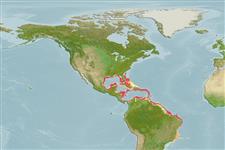>
Eupercaria/misc (Various families in series Eupercaria) >
Gerreidae (Mojarras)
Etymology: Eucinostomus: Greek, eu = good + Greek, kyon = dog + Greek, stoma = mouth (Ref. 45335).
Eponymy: John Matthew Jones presented the type specimens to the British Museum. [...] (Ref. 128868), visit book page.
More on author: Günther.
Environment: milieu / climate zone / depth range / distribution range
Ekologi
marina bottenlevande. Tropical; 32°N - 33°S
Western Atlantic: Bermuda and Florida, USA to Brazil.
Size / Vikt / Age
Maturity: Lm ? range ? - ? cm
Max length : 20.0 cm TL hane/ej könsbestämd; (Ref. 7251); publicerad maxvikt: 16.90 g (Ref. 118626)
Apparently does not enter estuaries or freshwater and may occur in slightly deeper water, and on banks that are farther offshore than those usually inhabited by Eucinostomus argenteus (Ref. 7251).
Life cycle and mating behavior
Könsmognad | Reproduktion | Lek | Ägg | Fecundity | Larver
Böhlke, J.E. and C.C.G. Chaplin, 1993. Fishes of the Bahamas and adjacent tropical waters. 2nd edition. University of Texas Press, Austin. (Ref. 5521)
IUCN Red List Status (Ref. 130435: Version 2024-2)
Threat to humans
Harmless
Human uses
Verktyg
Special reports
Download XML
Internet-källor
Estimates based on models
Preferred temperature (Ref.
123201): 21.3 - 27.4, mean 25.2 °C (based on 56 cells).
Phylogenetic diversity index (Ref.
82804): PD
50 = 0.5010 [Uniqueness, from 0.5 = low to 2.0 = high].
Bayesian length-weight: a=0.01905 (0.01170 - 0.03102), b=3.03 (2.89 - 3.17), in cm total length, based on LWR estimates for this species & Genus-body shape (Ref.
93245).
Trofisk nivå (Ref.
69278): 3.2 ±0.3 se; based on size and trophs of closest relatives
Resiliens (Ref.
120179): Hög, lägsta populationsfördubblingstid mindre än 15 månader (Preliminary K or Fecundity.).
Fishing Vulnerability (Ref.
59153): Low vulnerability (10 of 100).
